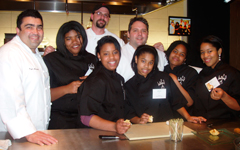Healthy Baking: Who, What, Where, When, Why and How
This weeks blog post is written by Jennie Basile, Intern at Brainfood Summer Institute and a rising Senior at Virginia Tech.
As the first week of Summer Institute comes to a close, the aromas from the healthy baking day still linger in my recent memory. I am a sucker for all things sweet, but as a major in Human Nutrition, Food and Exercise, I am especially fond of throwing in the word “healthy” in front of sweet treats.

WHAT: Brownies typically have large amounts of butter, oil, eggs and sugar. By adding the black beans, you are able to remove the eggs and oil, as the beans add a natural moisture and binding agent. In addition, beans are packed with protein leaving you fuller and even more satisfied. In the Brainfood kitchen, we opted for whole wheat flour. Whole wheat flour has more fiber and more nutrients, which are not found in the heavily processed all-purpose flour that is typically used. Next was the ever daunting Zucchini Muffins. In this recipe, unsweetened applesauce was used which added natural sweetness and moisture to the muffins. It also allwed us to take out butter and processed sugar. This swap also enhances your satiety and leaves you less likely to fall victim to the dreaded sugar crash later on. Similar to the Black Bean Brownies, whole wheat flour was used as well. Adding more spices to Zucchini Bread will add flavor without all the undesired processed sugars and fats. And it should go without saying, but zucchini is packed with all kinds of good nutrients! Adding a vegetable here and there is a win in my book! Lastly, the Quick Cinnamon Rolls were quite a hit. But before the cooking process started, the students learned that yeast is typically needed to make Cinnamon Rolls, but in our case, using low fat cottage cheese in the dough gave the rolls body and saved time.
WHERE: The youth worked diligently to create their baked goods and had tons of fun getting more familiar with the Chinatown kitchen and their peers.
WHEN: As the end class neared, the goods began to be pulled from the oven. The air was saturated with the sweetest of smells, exciting me and the students. Everyone joined in a collective effort to plate the healthy baked goods.
WHY: As we discussed the recipes and their final health benefits, we had our first tastes. Everyone in the room was delighted with how their creations had turned out and how they couldn’t taste the swapped ingredients much, if not at all! First hand proof that being a little conscious of what you’re putting in your desserts doesn’t have to sacrifice the taste.
HOW: A positive, creative and open-mind, of course!

.190x190.JPG)
.190x190.JPG)

.190x190.JPG)


Comments
Post new comment